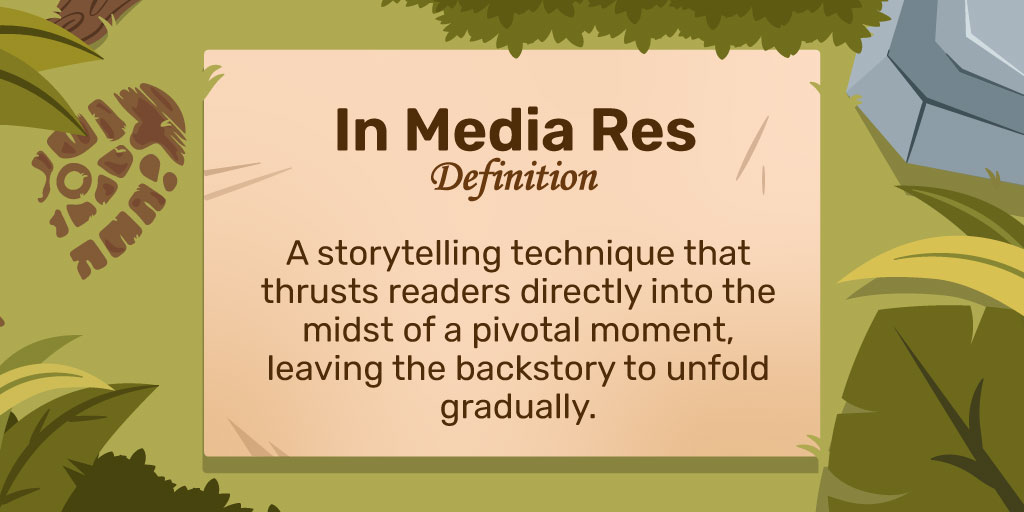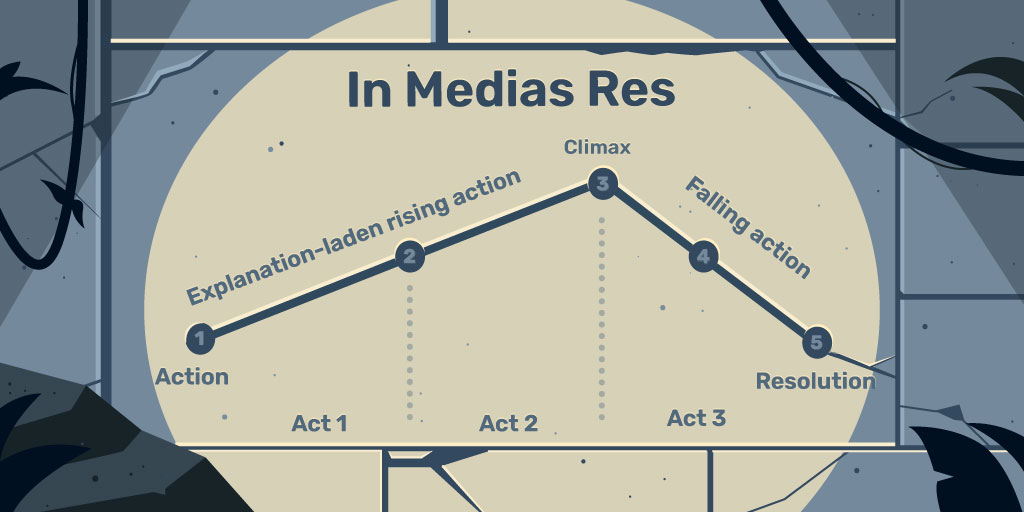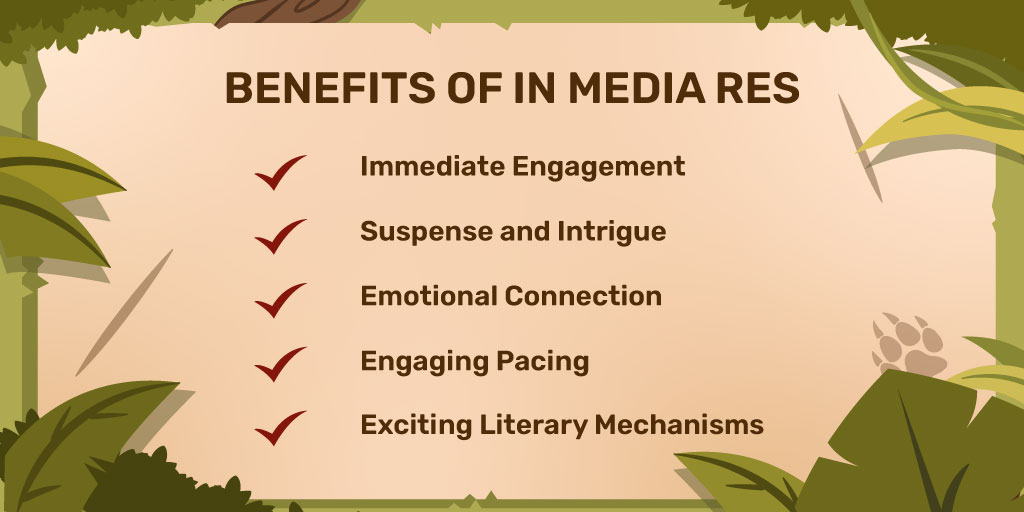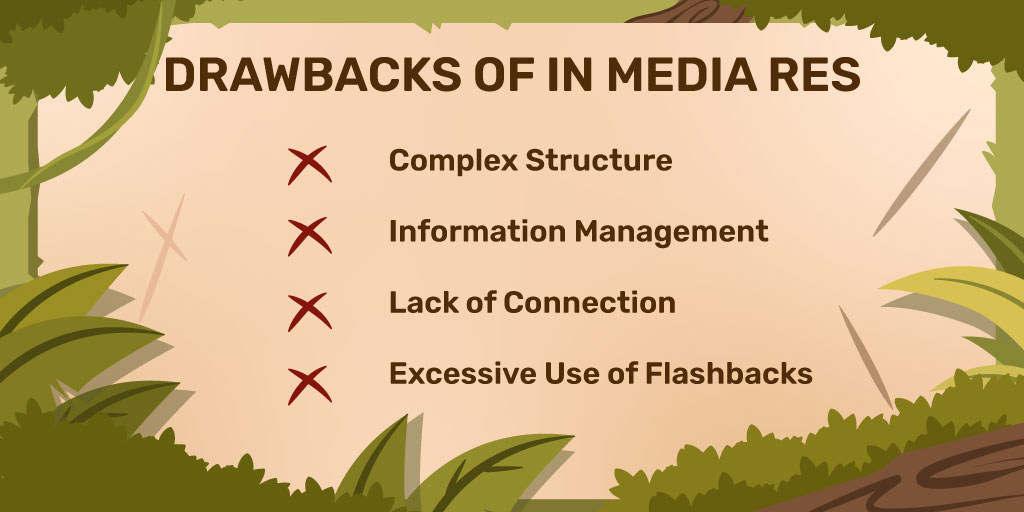Authors have long known that the key to capturing hearts was to start in the midst of things, in the middle of the action, with an opening that gives us glimpses of the challenges and misfortunes that are to come.
Imagine stepping into a world already in motion and the characters teeming with life, mid-stride in their challenging journey. This is the allure of In Medias Res, a storytelling method that plunges us headlong into a maelstrom of curiosity and excitement.
Join us as we embark on an exploration of this spellbinding storytelling technique of In Medias Res. We will explore its allure and delve into ways to use it effectively.
What Is In Medias Res?

In Medias Res is a Latin phrase that translates to “in the middle of things.” It refers to a storytelling technique where a narrative begins not at the chronological beginning of the plot but somewhere in the middle of the action.
Readers are thrown into a crucial or dramatic moment of the story without prior knowledge of the events leading up to it. The background and events that led to the initial scene are filled in later.
This technique is intentionally designed to plunge readers directly into the heart of the story’s conflict or an exciting event. By doing so, it aims to immediately captivate them, creating a sense of intrigue and curiosity about the characters and their predicament.
As the story unfolds, their curiosity is gradually satisfied as the missing pieces are artfully woven into the narrative through flashbacks, dialogue, and character interactions.

This contrasts with traditional narrative structures that follow a linear chronology, where the story unfolds in a sequence of events from the beginning, through the middle, and to the end. It often starts with an introduction of characters and the setting, followed by the gradual development of the plot leading to a climax and, finally, a resolution.
In Medias Res defies this linear structure by immersing the audience right into the midst of action, bypassing the chronological beginning. This provides a sense of immediacy and urgency to the story and challenges the audience to be more attentive, as they must piece together the backstory themselves.
Traditionally, a story in which detectives have to investigate a murder might start with the detective’s breakfast, during which they are called out to the murder scene. The murder is the inciting event, so it happens after the opening breakfast scene.
A story based on In Medias Res, on the other hand, might start where a relative takes revenge on the murderer for the killing of their loved one. The inciting incident, namely the original murder, happened sometime before the opening scene. Everything that led from it to the revenge will be filled in later.
Craft of Writing Quiz (Easy)

Examples of In Medias Res

Some authors are strongly attracted to In Medias Res as a storytelling method, and you will often find the same authors using this technique repeatedly throughout their careers. Ancient authors like Homer and more modern ones like Kurt Vonnegut started almost all of their works in the middle or the end. To illustrate how this technique has been used in practice, consider the three literary examples below.
“All the Light We Cannot See” by Anthony Doerr
Anthony Doerr’s “All the Light We Cannot See” won the Pulitzer Prize for fiction in 2015. It starts in the middle of the second world war, in different locations in the French town of Saint-Malo. Marie-Laure is a blind French girl who has joined the resistance and is broadcasting information to the Allies on a contraband radio. A brilliant German boy called Werner is also there, on a mission to locate and destroy anti-German radio broadcasts.
This opening immediately generates tension, as the activities of the two protagonists are in direct opposition. It also creates emotional engagement with both the characters, as they are both trapped in different locations in a town that is being bombed. Simultaneously, it evokes intrigue: how did a disabled girl become part of the resistance, and how did a seemingly decent boy become part of Hitler’s army?
These questions are all answered in flashbacks, as the story is told in three alternating timelines.
There is the mid-1930s, during which we follow Marie-Laure as she goes blind and learns to navigate her environment. During this same period, Werner grows up in an orphanage in a German coal-mining town.
Another timeline is the early 1940s, when Marie-Laure flees to Saint-Malo with her father and starts broadcasting resistance messages. Werner is at a state boarding school that teaches Nazi values, and is later sent to the military where he travels through Europe to track enemy broadcasts.
The third timeline is the 1944 events in Saint-Malo, where Werner successfully tracks Marie-Laure’s transmissions, but keeps quiet about her identity when he catches sight of her. Marie-Laure’s broadcasts ultimately save his life, while he saves her from a German officer that is about to kill her.
As such, the opening scene starts in the middle of the story. The missing details that brought the two protagonists to Saint-Malo are filled in gradually by the two earlier timelines, while the story simultaneously moves forward through the 1944 events. If the story had been traditionally told, starting in 1934 and moving forward, the intrigue would not have been present from the start, the tension would only have occurred towards the end, and the background exposition would have been very long.
“Little Fires Everywhere” by Celeste Ng
The winner of the Goodreads Choice Awards for Fiction in 2017, “Little Fires Everywhere” by Celeste Ng begins with a family home on fire and rumors that it was set alight by the family’s daughter, Izzy. Accordingly, the opening scene is the climax of the story and immediately evokes interest about why a girl would set her own family’s house on fire with her mother still inside.
The story then flashes one year back, when Mia and her daughter moved into a rental house owned by the Richardson family. Mia is a typical nonconformist, while the Richardson parents are the prototypical traditional, conventional suburban couple. This is the first source of tension between the two families, as teenager Izzy Richardson is strongly attracted to Mia’s creative, individualist ways.
After many other incidents in which Mia doesn’t act as the close, conformist community expected her to do, Mrs. Richardson forces her and her daughter to leave the rented house. Izzy is enraged with her mother for treating Mia so badly, and also with her brothers who used Mia’s daughter for their own ends. In revenge at the unjust treatment, she burns down their house and runs away, hoping to find and join Mia. From there, the story proceeds in chronological order to its end.
By starting the story at its climax and then flashing back to the events that led to it, the author creates constant suspense in the form of the question, “What is going to happen that is so extreme that it leads a teenager to burn down her family home?” Without this question in the readers’ minds, it would just be an ordinary, everyday story.
“Nineteen Minutes” by Jodi Picoult
A former #1 on the New York Times Best Seller list, Jodi Picoult’s “Nineteen Minutes” tells the story of a school shooting, including everything that led to it and its consequences for the shooter, the surviving kids, and the community.
It begins right in the middle of the story on the morning of the shooting, with the families of the shooter and victims having breakfast, and kids attending their classes and hanging around the cafeteria. Accordingly, it doesn’t start with a climactic scene, like the previous two examples did.
But it soon moves to the shooting itself, with detective Patrick Ducharme running into the school, passing dead and wounded kids, and arresting the shooter, Peter Houghton.
The rest of the story is told in two timelines.
The first is the present in which detective Ducharme and Peter’s lawyer investigate the crime, Peter’s parents and the town mourn, and the surviving kids try to move forward.
The second is the past, in which the events leading up to the shooting are revealed: from Peter’s first day at school during which his bullying started, to days before the shooting when the popular kids’ treatment of them bordered on torture.
By beginning the story in the middle, Picoult creates almost instant tension about what’s going to happen to the participants going forward. That’s also why she does not start with the shooting itself, but with an introduction to the characters before the shooting occurs. It gives readers characters with whom to identify before they are thrown into the middle of a disastrous event.
But the shooting scenes close to the beginning also make readers wonder what could have given rise to such a radical act, perpetrated by a seemingly decent boy against other apparently likable children. The flashbacks answer this question in an impressive amount of detail and in an emotionally engaging style.
How to Use In Medias Res

If this is the kind of story you like to read, and you want your own fiction to grab your readers’ attention in the same way, there are certain steps you can take to implement it successfully.
Step 1: Plan Your Story
You can choose between planning your story scene by scene or doing only a fairly rough outline. But it is essential to understand the gist of your story in chronological order so that you can plan where to start and what to flash back to.
Pantsers who enjoy making up their stories on the fly almost certainly find it easier to write linear narratives that follow events from beginning to end. It is not coincidental that the 21st-century’s most famous pantser, Stephen King, writes mostly linear novels. Think of “Carrie”, “The Shining”, “The Stand”, “Pet Sematary”, “Needful Things”, “Rose Madder”, “Under the Dome”, and most others – they all follow linear structures.
Those novels that he begins in the middle either start very close to the beginning of the story, such as “Misery”, or start with fairly vague scenes that give nothing away of the places to which he will have to jump back, such as “It.”
If you know the basics of your story because of enough planning, you can pick the best opening scene and the best ways to introduce the missing information later.
Step 2: Identify the Pivotal Moment
Identify a pivotal moment in your story that will serve as the starting point for the In Medias Res technique. Consider the following examples as ideal beginnings.
Pay attention to moments where emotions run high or conflicts reach a climax. These intense moments often make for excellent starting points for In Medias Res.
Examine the turning points in your story, where significant decisions are made or events unfold that alter the course of the narrative. These turning points can serve as compelling starting points for your text.
Assess the relevance of the pivotal moment to the overall story and its impact on character development. Choose a moment that reveals crucial information about the characters or propels the plot forward significantly.
Select a moment that evokes curiosity and intrigue. Ideally, the readers should be left with questions that drive them to read further to uncover the story’s underlying reasons and connections.
Step 3: Craft a Gripping Opening
Create a gripping opening that throws readers directly into the heart of the story. It doesn’t have to be an action scene; it can also be an intriguing one.
Use descriptive language to paint a vivid picture of the setting and the characters. Engage the readers’ senses, allowing them to feel like they are present in the scene, witnessing the events unfold firsthand.
Evoke emotions in the opening lines to establish an immediate emotional connection with the readers. Whether it’s excitement, fear, wonder, or sadness, stirring emotions will help readers become invested in the story.
Introduce a compelling and relatable character in the opening scene. Readers are more likely to become invested in the story if they can connect with the protagonist or other central figures. Show their emotions, goals, or dilemmas to make them more intriguing.
Step 4: Establish Context Gradually
As you move forward with the narrative, gradually introduce context and backstory through flashbacks, character dialogues, or introspection. Piece together the events leading up to the pivotal moment to provide a deeper understanding of the characters’ motivations and the situation at hand.
Avoid overwhelming your readers with information dumps. They’re boring to read and difficult to remember. Reveal the backstory in layers rather than dumping all the information at once. Gradually peel back the layers, allowing readers to discover new facets of the characters and the plot as the story progresses.
Incorporate flashbacks or memory sequences to reveal snippets of the past and provide context for the current events. These can be triggered by the characters’ thoughts, interactions, or external cues, allowing readers to piece together the backstory in a natural and engaging way.
Or leverage character dialogues to subtly reveal information about the past. Conversations between characters can allude to past experiences, relationships, or shared memories, offering valuable context to the readers.
Another way is to use inner monologues and reflections to delve into a character’s thoughts and emotions. This introspective approach allows readers to gain insights into the character’s past experiences and motivations.
Step 5: Use Flashbacks Wisely
Flashbacks are a powerful tool in the In Medias Res technique, but they have to be used well to avoid confusing your readers.
Ensure that each flashback serves a specific purpose in advancing the story. Whether it’s revealing a character’s motivations, explaining a significant event, or adding depth to a relationship, each flashback should contribute meaningfully to the narrative.
Timing is also crucial. Avoid using them too early in the story, as it may disrupt the present-day momentum. Introduce them at points where they will have the most significant impact on the reader’s understanding and emotional connection to the characters.
Transition smoothly into and out of flashbacks to avoid jarring the reader. Use appropriate cues, such as a trigger word, a change in tense, or a distinct formatting style, to signal the shift in time and ensure the reader can easily distinguish between the present and the past.
Lastly, they should be relatively concise and focused on the key elements of the past event. Avoid overly long or tangential detours into the past, as it can disrupt the flow of the main narrative.
Step 6: Balance Suspense and Revelation
Strike a careful balance between suspense and revelation. If your story alternates between present and past timelines, most of the former will come from the present and most of the latter from the past.
The danger of not doing enough revelation is that your suspenseful bits won’t be suspenseful enough. And the problem with too much revelation is that it’s boring.
Step 7: Focus on Character Development
Since readers are thrown into the midst of the story, near-instant character development is crucial.
Use the events unfolding in the present to showcase the personalities, beliefs, and flaws of your characters. This will allow readers to connect with and empathize with them on a deeper level. Show their traits and emotions through actions, dialogue, and inner thoughts.
Pros & Cons of In Medias Res
Like all storytelling techniques, In Medias Res is perfect for some stories and situations and unsuitable for others. Let’s explore the circumstances in which it works and fails.
Benefits of In Medias Res

This storytelling method has more advantages than disadvantages, which explains why it is so popular when in the hands of a skilled author. Consider the factors that make this technique so powerful:
- Immediate Engagement: In Medias Res benefits both authors and readers by hooking the latter from the very beginning, immediately capturing their attention and drawing them into the story.
- Suspense and Intrigue: Both also gain from the fact that it maintains a level of suspense throughout the narrative, keeping readers intrigued and eager to uncover the backstory.
- Emotional Connection: By experiencing a pivotal moment early on, readers develop a strong emotional connection to the characters and their journeys.
- Engaging Pacing: In Medias Res often results in dynamic pacing, with a balance of action and either introspection or revelation that keeps readers engaged.
- Exciting Literary Mechanisms: It opens up opportunities for exciting literary mechanisms, like the foreshadowing of future events to build anticipation, and flashbacks to build interesting connections between past and present.
Drawbacks of In Medias Res

In Medias Res has no real disadvantages if it’s done well. But the quest to do it well and the failure to manage it properly certainly pose problems. Here are a few things to keep in mind:
- Complex Structure: Crafting a compelling In Medias Res narrative with seamless transitions and gradual revelations can be challenging, requiring careful planning and execution to avoid disorienting or confusing readers.
- Information Management: Balancing the release of information and avoiding information overload can be tricky, as authors must ensure that readers have enough context to follow the story.
- Lack of Connection: If authors struggle to humanize the characters instantly, readers might struggle to connect with them early enough to make them want to keep reading.
- Excessive Use of Flashbacks: If flashbacks are overused or not well-integrated, readers might feel overwhelmed or distracted by constant shifts in time and perspective.
7 In Medias Res Alternatives

The great benefit of In Medias Res is that it creates intrigue or a mystery in your readers’ minds. But, in some cases, you can achieve something fairly similar without starting the story in the middle and struggling with flashbacks to fill in what’s missing. The same is true for immediate excitement, which can be produced through other mechanisms.
Let’s look at some potential alternatives to In Medias Res that allow you to stick to a linear or simpler storytelling form.
1. Multiple Viewpoints
The most common technique is to tell the story from multiple points of view, each character offering unique insights into the plot. By doing so, you can reveal different aspects of the story while still keeping certain elements hidden until the appropriate time.
This is especially easy if you have characters with clashing beliefs, goals, or allegiances. This can lead to conflicts and plot twists, keeping readers engaged as they follow the characters’ evolving relationships.
You can then gradually reveal how the characters’ stories intersect and connect. This slow unveiling can create anticipation and excitement as readers anticipate the full impact of their shared experiences.
2. The Unreliable Narrator
Particularly popular in the mystery and thriller genres, you can introduce an unreliable narrator who intentionally or unintentionally withholds or distorts information. This character might have biases, secrets, or personal reasons for not revealing everything, adding an extra layer of mystery and complexity to the story.
Introduce your narrator as a seemingly trustworthy source of information at first, but gradually drop subtle hints that they might not be entirely reliable through, for example, contradictory statements.
Keep their motivations ambiguous, leaving readers wondering why they are withholding or distorting information. Their hidden agenda adds a layer of intrigue, making readers question their true intentions.
Reveal the cracks in the narrator’s reliability bit by bit, allowing readers to piece together the discrepancies in their account. This gradual unraveling creates suspense and excitement as readers seek to uncover the real story.
For example, in a dark psychological thriller, the narrator presents themselves as a charming and charismatic individual. However, as the story unfolds, readers realize that they are a psychopathic serial killer, manipulating events and deceiving both the other characters and the audience.
3. Cliffhangers and Teasers
End chapters or sections with cliffhangers or teasers that hint at upcoming revelations. This technique keeps readers eager to continue reading and uncover the missing information.
Unresolved conflicts, dilemmas, or crucial decisions are good cliffhangers. Raising unanswered questions at the end of chapters also works.
One of the best cliffhangers is to drop bombshell revelations at the end of chapters that challenge readers’ assumptions or drastically change the direction of the story. The shock factor keeps readers interested.
In a thrilling adventure novel, for instance, the protagonist and their team find themselves trapped in a sinking ship, racing against time to escape before it’s too late. As they struggle to find a way out, the ship’s lights flicker, signaling a power failure and leaving readers on the edge of their seats at the end of a chapter.
4. Parallel Timelines
Use parallel timelines to present different events happening simultaneously. By switching between timelines, you can control the flow of information and create suspense as readers piece together the connections between the interconnected stories.
Plan climactic moments or revelations to occur simultaneously in different timelines. This synchronization can heighten the sense of anticipation and excitement as readers witness pivotal events unfold in multiple storylines.
Say humanity is struggling to survive in the aftermath of a cataclysmic event. The parallel timelines depict the journey of two groups of survivors—one focused on adapting and rebuilding society, while the other descends into savagery.
5. Epistolary Format
Adopt an epistolary format, where the story unfolds through letters, diary entries, or documents written by various characters. This approach allows you to control the information available to readers and offer different perspectives on events. By doing this, you can also hide information and create intrigue.
For example, create conflicts and discrepancies in the accounts provided by different characters. Readers will be intrigued to discover the truth behind these conflicting perspectives.
Imagine a contemporary romance, in which the story unfolds through emails exchanged between two characters who meet through an online forum. The emails reveal their growing connection, sharing thoughts, experiences, and emotions, while their offline lives and intentions may not be as consistent with their writings.
6. An Exciting Relevant Opener
If you want to create immediate excitement without starting your story in the middle, write a prologue with a high-stakes event or intense action sequence that is related to the story.
For example, when writing a survival story in which your characters are tourists who visit a dangerous cave, write a prologue from 10 years before where tourists get lost and starve in that same cave. It maintains a chronological structure and introduces immediate tension, not just in the opening scene, but also for the characters your readers don’t even know yet.
7. Fichtean Curve
The Fichtean Curve is a story structure in which authors don’t use an exposition or introduction to characters and events, but instead dive straight into the first conflict. This also creates instant action and excitement while sticking to a linear story structure.
If you want to write a detective story, for example, start with a murder that occurs in the detective’s neighbor’s house. It’s the inciting event, so it occurs first, and it is immediately exciting.
Frequently Asked Questions
If In Medias Res interests you as a story structure, and you are wondering about its uses, pros, and cons, this section is bound to cover your questions.
What Does a In Medias Res Mean?
In Medias Res is a Latin phrase that means “in the middle of things”. It is a suitable name for a narrative technique where a story begins in the middle of the action or at a crucial point in the plot, rather than starting from the beginning.
Is In Medias Res a Literary Device?
In Medias Res is more a storytelling technique than a literary device, as it affects a whole story. Typical literary devices like metaphor, imagery, foreshadowing, and symbolism tend to touch only certain parts of stories.
Why Do Authors Use In Medias Res?
Authors use In Medias Res to instantly engage readers by starting the story in the middle of action, creating immediate suspense and curiosity about the events leading up to that point. It offers an exciting and dynamic opening, efficient storytelling without dedicated exposition, and allows for the immediate revelation of character features to facilitate a speedy emotional connection with the readers.
What is the Effect of In Media Res?
The effect of In Medias Res is to immediately immerse readers in the heart of the action, creating a sense of urgency and suspense from the very beginning. By withholding information about the events leading up to the starting point, it generates curiosity and compels readers to continue reading to uncover the backstory and motivations behind the characters and their circumstances.
What is the Opposite of In Medias Res?
The opposite of In Medias Res is a linear or chronological narrative structure, where the story starts from the beginning and unfolds in a straightforward, chronological order. In this approach, the events are presented in the sequence they occur, without jumping ahead or starting in the middle of action.
Final Thoughts
Using the In Medias Res narrative technique offers significant advantages for authors in capturing their readers’ attention and fostering an immersive reading experience. By thrusting readers into the heart of the action and withholding crucial information, authors create an immediate sense of intrigue, suspense, and emotional engagement. Embracing this storytelling method enable authors to write stories that leave a lasting impression on their audience, making it a valuable tool in the literary toolbox.
Craft of Writing Quiz (Hard)








